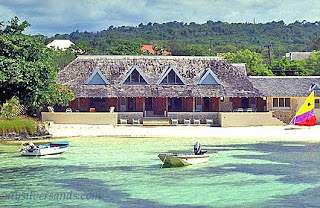Silver Sands Jamaica - A History by H. S. Ive
What is now known as Silver Sands was originally a port for the shipping of sugar and rum from what was then called Derby Wharf. The Jetty was built to accommodate the schooners that came from England for the produce, and was the main reason for the formation of the beach which, of course, was called Derby Beach.
The parish of Trelawny, at the start of the Nineteenth Century, had the largest number of sugar estates in Jamaica. The over ninety estates were reduced after the abolition of slavery in 1838 but a large number of these estates continued to produce sugar and rum into the Twentieth Century. When Derby Wharf operated as a wharf, the owners of the facility was the Sewell family who, apart from having numerous sugar estates, had a beautiful home and "Great House" at Arcadia which overlooks the shoreline around the Derby Beach area. The little district that this home is situated in is called Samuel Prospect and the "Great House" is currently owned by Mr. Heinz Simmonich, Managing Director of Half Moon Hotel in Montego Bay and also the Austrian Consul to Jamaica.
The Sewell's were a very influential English family who were some of the early investors in Jamaica, and also had their own castle on the Isle of Wight and so naturally spent a lot of time in England. They were also benefactors of St. Michael's Anglican Church at Clarks Town in the parish where numerous members of the family are buried. To highlight their importance in an international sense it should be noted that shortly after the commencement of hostilities in the Second World War, the British Military Attaché to the American Government in Washington DC was Brigadier General, The Hon. H. S. Sewell.
As the decline of the sugar industry in the parish continued and large steam boats took over the Marine Trade, at Derby Wharf the total trade collapsed and the property was eventually sold to a Mrs. McIntosh. The land that came with the property was useless for agriculture as it was chiefly honeycomb rock. The value of the beach was however recognized even at this early stage and Mrs. McIntosh used to charge a small sum for adults and children to swim there, particularly on weekends and during the annual bird shooting season in August and September. At this time the chief patrons were the sugar estates senior personnel. As business improved, what was a facility for the operation of the wharf was renovated and turned into a cottage for rent. This took place in the latter part of the 1920s and soon became very popular.
In the early 1940s, a Trinidadian, Mr. Robert Huggins and his Grenadian wife, Joy, purchased the property as well as an adjoining property to the West known as Johnston Pen. The first thing that they did was to convert the old warehouse that was structurally sound to be their home. This is the beautiful home to the West of the Jetty, called "Rum Jetty". During this construction period, the Huggins made friends with the local patrons of the beach at the weekends and the only change was that the small fee that used to be charged for using the beach was discontinued. The only other thing of note was that the Johnston Pen property was changed into a modern stud farm for the breeding of racehorses and in due course the Huggins' were some of the most formidable racehorse owners in the Island.

Rum Jetty, 2000
On the completion of their home, the Huggins took up residence at "Rum Jetty" and the norm was for one or other of the pair to come out to the beach around noon on a Sunday and ask all the bathers over to their home for drinks. This continued for a few months until the locals felt that this was not fair to the Huggins and on a fateful Friday evening the Huggins were told that the status quo could not continue. The locals were adamant that either they be allowed to bring liquor to the beach or better still have a licensed bar set up at the beach so that they could reciprocate the Huggins' hospitality. This was the start of what is now known as Silver Sands. The Silver Sands Beach Club was formed and a Club House was constructed. The bar was called the "Jolly Friar" bar, named after Mrs. Huggins' record breaking racehorse and the horseshoes of this illustrious horse adorned the walls of the bar. The Huggins then started an expansion of cottage facilities and over a half a dozen were constructed.
In November 1953, Her Majesty Queen Elizabeth II with her Consort H. R. H. The Duke of Edinburgh were to pay an official visit to Jamaica. They were to land at Montego Bay in the morning, have an official welcome and then proceed to Kings House in Kingston. The Huggins were asked if they would host the Royal Entourage to lunch and this was readily agreed. The two cottages nearest the beach were then prepared for the Queen and the Duke respectively. The Duke had a swim and then everyone went to lunch. After a truly Caribbean lunch, the Party left on their official duties but the two cottages from then became known as "The Queen's Cottage" and "The Duke's Cottage".

Queen's Cottage, December 2009
(the above, written by H. S. Ive in September 1996, was contributed by Gordon Stewart of Queen's Cottage.)
See also A history of Silver Sands by Eileen Clarke.
All about Silver Sands
Go to Queen's Cottage.


